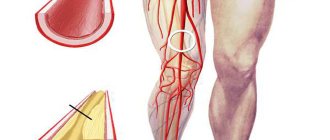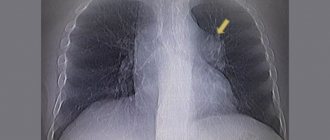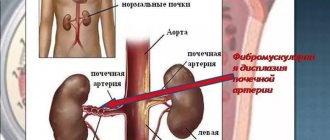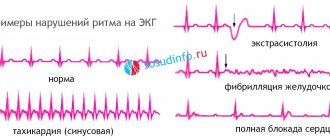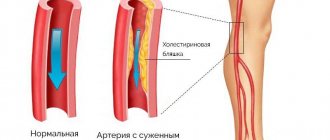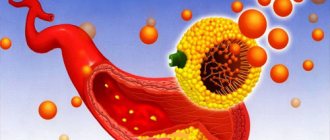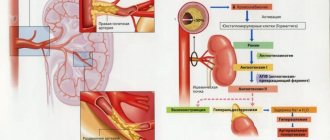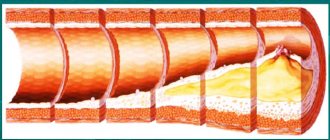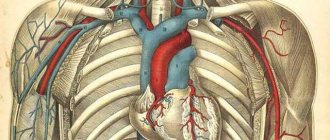What is pulmonary aortosclerosis and how to treat it
A large pair of blood vessels extend from the heart to the lungs, which supply deoxygenated blood (freed of oxygen) to the lungs.
The pulmonary trunk is divided into 2 branches - right and left. Venous blood flowing to the lungs through these arteries plays an important role in pulmonary circulation. Any disruption of these arteries can be fatal. The aorta is the largest arterial vessel in the body, from which all the arteries involved in the systemic circulation depart. It originates from the left ventricle of the heart. With aortic stenosis, it narrows, which causes arterial sclerosis.
In the first case, blood pressure remains within normal limits, and in the second, the pressure in the aorta increases. The disease manifests itself at the age of 60-65 years. At the beginning, the disease is asymptomatic. Complications occur with hypertension or narrowing of the vascular openings. The disease can affect both small and large vessels.
At the initial stage, changes occur in those vessels where the greatest blood flow occurs. Blood clots form in these parts.
At the same time, the body tries to cope with the disorders itself by producing special enzymes. But when there is a shortage of enzymes, proteins accumulate in the vessels.
This process leads to the formation of a fatty plaque and the appearance of small ulcers. The most difficult condition is the accumulation of calcium salts along with fatty deposits.
Such vessels can only be treated surgically.
Aortosclerosis of the lungs, also called atherosclerosis, is a disease in which cholesterol plaques form, blocking the artery of the lung and thus causing it to narrow. This provokes problems with oxygen saturation of the lungs and, accordingly, the whole body, causing serious complications, including death.
Aortosclerosis most often develops in:
- residents of large cities;
- people over 45 years of age.
In men, this problem can arise 10 or more years earlier than in women, with similar heredity and lifestyle.
Causes and symptoms of the disease
Aortosclerosis is a disease that, as a rule, becomes one of the accompanying pathologies and develops as their natural consequence. As a rule, these are pathologies that affect the level of pressure in the lungs.
Main causes of pathology
The formation of a lipoprotein plaque in a vessel (atherogenesis) is a complex multi-level biochemical process that occurs against the background of the following causative and provoking factors:
- hypercholesterolemia;
- lipid metabolism disorder;
- change in vascular pressure;
- inflammation of the endothelium (inner lining of the artery);
- endocrine disorders (obesity, diabetes);
- unhealthy lifestyle (low physical activity, poor nutrition, bad habits, chronic stress).
The following diseases are important for the occurrence of atherosclerotic disease in the arteries of the lungs:
- heart defects that provoke idiopathic pulmonary hypertension (mitral stenosis, heart failure);
- lung diseases (emphysema, chronic obstructive disease, respiratory system abnormalities);
- blood diseases;
- endocrinopathies;
- thromboembolism of the great vessels.
Impaired blood flow in the pulmonary arteries leads to dangerous and serious problems associated with the delivery of oxygen-rich blood to vital organs and systems of the body.
Causes
Pulmonary artery atherosclerosis most often occurs in people over forty-five years of age. However, nowadays the disease increasingly affects younger people - 30-35 years old, and in some cases it is diagnosed even at 20-25 years of age or even earlier.
The following factors contribute to the development of pulmonary artery sclerosis:
- morphological changes in the vascular system;
- pathology of lipid metabolism;
- excess weight;
- psychological disorders leading to an increase in adrenaline in the blood;
- inflammatory processes;
- hormonal disorders;
- hemodynamic disorders;
- infectious diseases;
- chest injuries;
- pleurisy;
- metabolic disorders;
- influence of ionizing radiation;
- weakened immune system.
A common factor in primary diffuse atherosclerosis is Ayers syndrome - arterial sclerosis, characterized by a constant increase in the pressure of the pulmonary circulation in the medium and large branches of the vessel. Due to a lack of oxygen in the tissues and an increase in hemoglobin, the patient develops a sharp diffuse cyanosis - the skin darkens and becomes bluish in color.
Risk factors for diffuse atherosclerosis:
- genetic disorders of arterial walls;
- endothelial dysfunction;
- excessive percentage of cholesterol contained in the blood;
- persistent increase in pressure in the pulmonary vessels and capillaries;
- hypertension;
- weak immunity;
- hormonal disorders;
- diabetes;
- poor diet with high fat intake;
- damage to arterial tissue by viruses, such as herpes;
- metabolic disease;
- severe stress conditions and constantly high levels of adrenaline in the blood.
Diffuse atherosclerosis can accompany a number of diseases. Mitral stenosis causes a decrease in the opening of the same name in the heart, which prevents blood from passing freely from the left atrium into the ventricle and leads to increased pressure. Most often, this disease develops against the background of rheumatic fever.
In chronic pulmonary diseases, such as bronchial asthma, pulmonary emphysema can develop - a pathological change in tissue leading to loss of elasticity, the ability to fill and subside, which leads to overcrowding with air and impaired ventilation of the organ, as well as damage to the walls of the alveoli and blood vessels.
Lung fibrosis causes the formation of scarring, the irreversible replacement of lung tissue with connective tissue, which is unable to stretch and maintain gas exchange function. This leads to cyanosis, lack of oxygen in the arteries and increased blood pressure.
The following factors can trigger the development of pulmonary atherosclerosis:
- Inflammatory processes.
- Serious vascular injuries.
- Constant stress and unstable emotional background.
- High cholesterol and excess body weight.
- Improper and unbalanced nutrition.
- Problems with the endocrine system.
- Diabetes mellitus and other autoimmune diseases.
- Increased pressure in the lung area.
- Inactive lifestyle.
- Smoking tobacco.
- Drinking alcoholic beverages.
The danger of ignoring pulmonary atherosclerosis is the deposition of platelets on the walls of blood vessels, due to which they are slowly destroyed. Also, due to this disorder, the lung tissue begins to produce specific substances that make the walls of blood vessels thicker.
After atherosclerotic plaques attach to it, blood circulation and oxygen supply can be completely blocked.
Why is it dangerous?
One type of dangerous complication is vascular thrombosis, which can cause a heart attack or stroke.
A frequent complication of atherosclerosis of the pulmonary aorta is cardiosclerosis. It occurs due to impaired blood supply in the vessels of the heart and increased load on this organ. It is also possible to develop pneumosclerosis and replacement of normal lung tissue with connective cell elements with disruption of the functional activity of the organ. Another danger is vascular thrombosis, which leads to heart attack, stroke, kidney or liver failure. If the aorta is damaged at the site of formation of an atherosclerotic plaque, a vessel aneurysm is possible with its subsequent rupture and internal bleeding.
Stages of disease development
There are several stages of development of the atherosclerotic process in lung tissue.
First stage. Its manifestations begin with changes in the internal walls of blood vessels in areas with the strongest blood flow - where the aorta and large vessels and arteries connect.
Examination at this stage reveals the presence of minor endothelial disorders. Then the cellular channels expand and increase, resulting in the formation of flat microthrombi, causing an increase in the permeability of endothelial cells.
At this stage, the products of pathological metabolism are removed from the cells by intimal enzymes;
Second stage. Its development begins when the activity of lipolytic and proteolytic enzymes decreases.
Harmful substances accumulate in the arteries, which causes a disruption in the amino acid structure of elastin. This causes its fibers to increase in size.
In this case, the inner membrane is divided into fragments, and the intima is divided into fibers; its tissues absorb fats and turn into xanthoma cells. At this stage, upon examination, spots of fat cells and light-colored stripes may be detected;
Classification of the disease
Depending on the spread of the process, the disease is divided into the following types:
- focal - connective tissue has replaced a small area of the organ. Foci of sclerosis in the lungs are small, medium and large. May be single or multiple. Untimely treatment will lead to progression of the disease;
- segmental - covers the entire area of the segment of the respiratory organ;
- limited (lobar) - connective tissue covers the entire lobe of the lung. This leads to respiratory dysfunction;
- diffuse - characterized by the formation of large foci spreading throughout all segments of the organ. Diffuse sclerosis of the lungs is dangerous because the connective tissue almost completely displaces the pulmonary tissue;
- mixed - a rare form in which two or more lesions are observed simultaneously.
Based on the degree of proliferation of connective tissue in the pulmonary parenchyma, the following are distinguished:
- pneumofibrosis;
- pneumosclerosis;
- pneumocirrhosis.
Each type has its own symptoms.
Pneumofibrosis
Pneumofibrosis is the initial stage of pulmonary pneumosclerosis. It occurs as a consequence of damage to the pulmonary system, a person living or working in a polluted area, or heredity. Pneumofibrosis belongs to the general group of pneumosclerotic diseases with the slowest growth of connective tissue.
There are local and diffuse types, each of which is characterized by progressive and non-progressive stages. The first threatens the formation of an abscess. The non-progression stage is practically asymptomatic and, subject to the correct lifestyle, does not interfere with the person.
Symptoms of pulmonary fibrosis are as follows:
- cough with sputum and purulent masses;
- chest pain that gets worse when coughing;
- temperature changes;
- sudden weight loss for no apparent reason.
Chest pain that gets worse with coughing may be symptoms of pulmonary fibrosis.
Pulmonary fibrosis can be detected using an x-ray. The procedure shows signs of the disease, as well as the presence of concomitant ailments. Additionally, tests are prescribed, bronchoscopy, and respiratory function is assessed.
Therapeutic measures are aimed at eliminating the cause or treating the primary disease. The doctor prescribes antibacterial drugs in conjunction with physical therapy. Also, patients with pulmonary fibrosis are prescribed drugs that help with sputum discharge (Bromhexine) and a special lying position that promotes expectoration. Advanced forms are treated surgically, after which the patient is observed by a pulmonologist for another year.
Pneumosclerosis
With this type of disease, the pulmonary parenchyma is replaced by connective tissue with compactions and completely changes its structure. The causes are untreated infectious diseases, circulatory diseases, congestive processes in the lungs.
If pneumosclerosis is not detected in time, the pathology will lead to a malfunction of the respiratory system, a deterioration in a person’s quality of life, the development of cardiopulmonary failure, and in the case of a secondary viral or bacterial infection, it can lead to death.
In addition to radiography, MRI is prescribed to diagnose pneumosclerosis.
The degree of damage to the lungs and the location of the inflammation process is determined using radiography. Additionally, MRI, tomography, spirometry, as well as bronchoscopy and physical examinations are prescribed.
Therapy for pneumosclerosis begins with eliminating the inflammatory process. In case of bronchial or pneumatic provocation of the development of the disease, antibacterial, anti-inflammatory and expectorant drugs are prescribed. Therapeutic breathing exercises, hardening, and swimming are also attributed.
Pneumocirrhosis
The most dangerous stage of the development of pulmonary sclerosis, which is characterized by thickening of the pleura, replacement of the bronchi, alveoli and blood vessels with collagen, and impaired gas exchange functions. Occurs as a result of advanced tuberculosis, long-term use of antibiotics and the development of pleurisy.
Pulmonary cirrhosis is characterized by a long course and can be unilateral or bilateral. In both cases, sclerotic changes in the lung tissue form. The bronchi are subject to deformation, sclerosis of the pulmonary vessels occurs, the mediastinal organs are displaced, and emphysema appears in the vicinity of the lungs.
In medicine, there are several classifications of pneumocirrhosis:
- with local damage;
- with frequent relapses;
- with bronchiectasis;
- causing destruction of organ tissue.
A patient with pneumocirrhosis may experience severe intoxication of the body, cough with sputum, sometimes with blood. As the disease progresses, dysfunction of other internal organs is observed.
The disease is diagnosed using a number of procedures:
- interview and examination of the patient, during which the doctor learns about complaints, previous diseases, and external factors in the manifestation of the disease;
- general blood, urine and sputum tests;
- listening to the chest and tapping the lungs to determine the intensity of the disease and the degree of respiratory dysfunction;
- X-ray showing deformation of the lungs;
- biopsy is performed in advanced cases.
Pneumocirrhosis is treated comprehensively, starting with drug therapy. If it does not give the desired results, surgical intervention is used. All therapeutic measures are aimed at increasing the volume of oxygen supplied and preserving cardiac activity.
Symptoms
It is not always possible to determine the appearance and development of pathology in the early stages of the disease, since pulmonary atherosclerosis develops gradually.
Signs of pulmonary aortosclerosis and the severity of their manifestation depend on the type of pathology, its location in the body and the severity of the disease.
At the initial stage, it is impossible to identify diffuse atherosclerosis without examination - the disease develops slowly and initially without pronounced symptoms. During diagnosis, it is possible to detect initial lesions of the vascular walls and endothelium in areas where the blood flow pressure is highest.
Atherosclerosis in the lungs develops slowly and gradually; not in all cases a person can notice the symptoms of this pathology in the early stages. Most often it is diagnosed using functional studies or in advanced stages, when signs of the disease appear.
It is possible to recognize atherosclerosis based on the results of an X-ray examination by damage to tissues and blood vessels, enlargement of channels and the formation of microthrombi. Typically, atherosclerosis in the lungs can be recognized due to insufficient oxygenation of the blood.
This manifests itself in:
- Constant coughing for no reason, which may cause blood to be released.
- Unreasonable shortness of breath.
- Pain in the chest area.
- Constant drowsiness, fatigue.
- Reduced level of pressure in the pulmonary bag.
- Blue discoloration of the skin in the chest area.
If you detect at least one sign of pulmonary atherosclerosis, you must immediately contact your doctor. The presence of one symptom does not indicate the presence of this disease, however, when a second one appears, this is a good reason to think about a comprehensive diagnosis.
Main symptoms
With pathology, the patient develops symptoms such as cough, in some cases with blood.
Atherosclerosis in the aorta of the lungs causes the patient to develop the following characteristic clinical signs:
- shortness of breath on exertion, and in severe cases at rest;
- weakness;
- cyanosis of the skin;
- cough;
- sputum mixed with blood;
- chest pain;
- insufficient pulse wave strength and decreased peripheral blood pressure with high central blood pressure;
- trophic tissue disorders;
- changes in the shape of nails and hair loss.
Diagnostics
The best option for determining pulmonary atherosclerosis in the initial stages is the use of computed tomography.
With the help of this study, it is possible to study in more detail the condition of lung tissue and the vascular system.
In addition, with the help of tomography, lesions can be identified as accurately as possible.
The following tests are usually used to diagnose the disease:
- Taking an anamnesis, which involves examining and studying the disease, identifying chronic diseases in the patient;
- Examination of the fundus and iris;
- Blood test for cholesterol levels;
- X-ray examination to determine lung function;
- Ultrasound of the cardiovascular system and abdominal cavity;
- Full scan of the pulmonary artery and blood vessels.
Sclerosis of the pulmonary artery is detected by the results of an X-ray examination. The presence of cyanosis and pathological processes in the respiratory and cardiovascular systems is checked.
In addition to radiography, other types of examinations are also practiced:
- blood test (general, biochemical);
- immunogram (examination of blood and other body fluids to assess the state of the immune system);
- sputum analysis (general and bacterial);
- dopplerography;
- electrocardiogram;
- echocardiography;
- Magnetic resonance imaging;
- CT scan.
The patient is interviewed and the medical history is studied. The heart is listened to for the presence of systolic (sometimes diastolic) murmur, the eyes are checked for the presence of an atherosclerotic ring on the iris, and the patient’s body is also examined to identify signs of cyanosis on the skin, and lung volume is measured (spirography).
Next, a complete biochemical blood test is performed, the level of cholesterol, red blood cells and hemoglobin is checked, a bacteriological diagnosis of sputum, and an electrocardiogram are performed. The presence of accompanying diseases of the lungs and heart is revealed.
To clarify the diagnosis, the following procedures are performed:
- X-ray with the introduction of contrast fluid, detection of pulmonary hypertension;
- Ultrasound of the abdominal cavity, lungs and cardiovascular system;
- full scanning of the pulmonary aorta (Dopplerography), the degree of vascular damage is determined;
- computed tomography for the presence of foci of atherosclerosis in the lungs.
Pulmonary sclerosis - what is it?
First of all, pulmonary pneumosclerosis is a complex pathological process. The main characteristic is the fact that the pulmonary parenchyma changes to connective tissue, which does not perform any functions. This disease is also commonly called “pneumofibrosis.”
The development of the disease is preceded by dystrophic or inflammatory processes in the lungs. Subsequently, pulmonary sclerosis negatively affects the bronchi, they become deformed. The result of all this is that damaged areas of the bronchi do not conduct air well, which negatively affects the general condition of the human body.
This disease, as a rule, primarily affects children of completely different ages. Although it also occurs quite often in adults.
Both men and women are susceptible to multiple sclerosis, and you can find out how older people get atherosclerosis by clicking on the link.
Treatment
Several methods are used to treat pulmonary atherosclerosis, namely: correction of hormonal levels and general metabolism, lowering cholesterol levels in the blood, influencing the proper functioning and metabolic processes in the walls of blood vessels, as well as fermentation of the circulatory system.
This is done to activate lipolysis and fibrinolysis and weaken platelet aggregation.
Patients suffering from pulmonary atherosclerosis are recommended to eat properly and moderately exercise. It is beneficial to eat fermented milk products, lean fish and fiber found in fruits and vegetables.
After the doctor has clarified the diagnosis, drug treatment is usually prescribed. It can be divided into two parts accompanying each other. This is a drug treatment for atherosclerosis itself and the treatment of all associated diseases.
Medicines aimed at treating atherosclerosis are:
- Statins are aimed at suppressing the body's production of cholesterol and restoring the functions of the inner lining of the vessel. At the same time, blood flow improves, which reduces the risk of blood clots. Taking medications from this group significantly reduces the risk of inflammation of the atherosclerotic plaque.
- Fibrates – have the same goals, but they are more preferable for people with diabetes.
- Drugs aimed at creating hormonal balance.
In parallel with the fight against atherosclerotic formations, the attending physician will be faced with the task of eliminating all concomitant diseases. For this purpose:
- oxygen therapy;
- treatment of lung diseases and maintaining a normal respiratory system;
- conservative or even surgical treatment of the entire cardiovascular system;
- elimination of existing diseases of internal organs.
In addition to drug treatment, the complex should also include a number of preventive measures aimed at eliminating the causes of the appearance and development of these problems. Such actions should include:
- normalization of weight;
- following a diet low in fat and cholesterol;
- increasing physical activity through walking in the fresh air and playing sports;
- complete cessation of smoking;
- regular blood pressure control.
The entire complex of treatment, as well as preventive measures, require constant supervision by a doctor and compliance with all his requirements. This will help avoid negative complications and the development of concomitant diseases, which can lead to complete disability or even a completely bad outcome.
This problem is very serious, and it is important for the patient to remember that recovery largely depends on his mood and desire to lead a full life in the future.
Atherosclerotic deposits are treated in several ways:
- reduction of excess weight;
- correction of metabolism;
- regulation of hormonal levels;
- lowering blood cholesterol;
- decreased platelet aggregation;
- prescribing a special diet;
- selection of suitable physical activity;
- rejection of bad habits.
The diet involves eating enough protein foods, reducing animal fats, salt, sugar and carbohydrate foods. The use of fermented milk products, cottage cheese, fish, fruits and vegetables is beneficial. Polyunsaturated fatty acids contained in flaxseed and olive oils are of great benefit.
But diet alone is not enough; you need to use comprehensive measures, which include both drug treatment and traditional medicine.
Vessels should be treated with drugs from the group of statins, which prevent the absorption of cholesterol.
The surgical method of removing plaques is resorted to in case of complete blockage of the vessel. For drug treatment, the following drugs can be used:
- antibacterial;
- against tuberculosis;
- antiparasitic;
- hormonal;
- cytostatics.
Atherosclerosis can develop in the aorta, coronary vessels, and pulmonary artery. This affects the patient’s quality of life and leads to disability in the future. You should consult your doctor when an unpleasant burning sensation appears in the heart area, squeezing or stabbing pain, shortness of breath, a feeling of fatigue, or pressure surges.
Atherosclerosis destroys the blood vessels of the lungs due to the deposition of harmful cholesterol, proteins and calcium salts on their walls. At the initial stage, a person does not feel any special changes in his health, occasionally complaining of fatigue, shortness of breath and pain in the heart area. To avoid serious consequences, it is better not to ignore such symptoms.
Objectives of therapeutic measures for pulmonary aortosclerosis:
- overcoming respiratory failure;
- elimination of factors that led to sclerotic manifestations;
- avoiding complications.
The following methods are used for medicinal purposes:
- organization of a gentle daily routine (refusal of physical activity, bed rest);
- the use of drugs that reduce pressure in the pulmonary circulation;
- oxygen treatment;
- prevention of thromboembolism by taking anticoagulants;
- taking medications to support the cardiovascular system.
To treat respiratory failure, drugs from the groups of mucolytics, bronchodilators and glucocorticosteroids are used.
To combat the causes of aortosclerosis, the following groups of drugs are used:
- antibiotics;
- antituberculosis drugs;
- antiparasitic drugs;
- cytostatics.
If there is a heart defect, surgery is performed.
Complications of the disease
Any complications of aortosclerosis pose a danger to the patient’s life. The most common complication is myocardial cardiosclerosis.
With this disease, healthy myocardial tissue is replaced with scar tissue (from microscopic lesions to extensive ones). Thus, cardiosclerosis leads to ischemia - a reduction in blood flow to the organs.
If the complication affects the pulmonary circulation, pneumosclerosis is possible, as a result of which gas exchange is disrupted.
For diffuse pulmonary atherosclerosis, complex therapy is carried out, aimed primarily at correcting metabolism, normalizing weight and hormonal levels. Treatment of identified concomitant diseases is also carried out.
A patient diagnosed with diffuse pulmonary atherosclerosis is prescribed a diet with a sufficient amount of protein and a reduced content of animal fats, as well as salt and sugar. Lean fish, fermented milk products, vegetables and fruits, and olive oil will be useful. A balanced diet will help you lose weight, reduce blood cholesterol and improve your metabolism.
Also, patients with diffuse pulmonary atherosclerosis, depending on the stage of the disease, are prescribed moderate physical activity, gymnastics, and a special massage.
Among drug treatments, lipid-lowering drugs are first prescribed - they stabilize lipid metabolism in the body, interfere with the absorption of cholesterol and reduce its level in the blood.
The most effective drugs are those belonging to the group of statins (rosuvastatin, lovastatin), their action is based on blocking the enzyme responsible for the synthesis of cholesterol in the liver.
Statins in a short time improve the condition of damaged vessel walls, restore the proper functioning of the endothelium, reduce blood viscosity and have anti-inflammatory properties, thereby reducing the possibility of blood clots.
Statins are also indicated for diseases of the cardiovascular system, help recovery after stroke and myocardial infarction (and reduce the risk of their development).
Drugs of the fibrate group - fibric acid derivatives (ciprofibrate, fenofibrate, bezafibrate) control the synthesis of cholesterol transport proteins in the liver, lowering the level of low-density lipoproteins in the bloodstream, and slowing down the development of diffuse atherosclerosis.
Fibrates stabilize glucose metabolism; they are necessarily prescribed in the presence of diabetes mellitus among concomitant ailments. Contraindications for use are liver diseases.
Preparations containing niacin and omega 3 fatty acids also have a positive lipid-lowering effect. Lecithin also regulates lipid metabolism, improves liver function and lowers blood pressure. It is prescribed for both medicinal and preventive purposes, in combination with diet.
The main goal of therapy for pulmonary atherosclerosis is to minimize the risk of developing subsequent complications. It is also aimed at restoring the normal functioning of the pulmonary and cardiovascular systems.
To treat the whole body, a specialist needs to assess the state of the liver and conduct a study of the chemical composition of the blood, in particular the number of platelets. The use of medications will help stop the development of pulmonary atherosclerosis and restore some body systems.
In general, treatment of pulmonary atherosclerosis consists of:
- Taking blood thinning and anti-inflammatory drugs.
- Reducing blood cholesterol levels.
- Restoring normal hormonal levels.
- Normalization of blood flow.
- Establishing normal metabolism.
- Normalization of body weight.
To put the body in order, it is necessary to establish metabolism. To do this, the patient must adhere to a special diet and exercise.
It is very important that all therapeutic measures take place under the full supervision of the attending physician. With regular monitoring, a specialist will be able to detect changes in time and adjust the prescribed medications.
Usually, to fully restore the body with pulmonary atherosclerosis, it is necessary to take medications that lower blood pressure, improve blood flow, and strengthen the heart muscles.
If you do not understand what it is, pulmonary atherosclerosis, be sure to ask your doctor about it.
Pulmonary artery atherosclerosis
Pulmonary atherosclerosis most often occurs in people over 45 years of age and living in large cities or in unfavorable environmental conditions. Atherosclerosis usually occurs as a result of diseases that increase blood pressure. These include:
- Heart diseases;
- Emphysema, pulmonary fibrosis;
- Inflammatory processes in the inner layers of blood vessels;
- Age-related changes in the walls of blood vessels;
- Diseases characterized by lipid metabolism disorders;
- Arterial hypertension.
The risk group includes:
- Abuse of alcohol, smoking;
- Drug use;
- Diabetes;
- Obesity;
- High levels of cholesterol in the blood;
- Increased fragility of blood vessels;
- Physical inactivity;
- Hypothyroidism and hyperthyroidism;
- Increased levels of adrenal hormones in the blood.
Genetic predisposition, viral or infectious diseases, frequent stress and depression, hormonal imbalances and autoimmune dysfunction increase the likelihood of developing pulmonary atherosclerosis.
An increase in the amount of cholesterol in the blood is associated with poor diet and consumption of animal fats.
As a result, not only atherosclerosis occurs, but also coronary heart disease, vascular disease, brain and myocardial stroke, renal and liver failure, and Alzheimer's disease.
Reasons for the development of the disease
Atherosclerosis of the lungs often occurs as a consequence of diseases of the cardiovascular system and lungs, which cause constant increased pressure in the vessels of the small circle and branches of the pulmonary artery.
The reasons that provoke the development of atherosclerosis also include:
- Immune system diseases;
- Increased levels of lipoproteins in the blood;
- Endothelial damage;
- The appearance of chlamydia on the inner walls of blood vessels;
- Chronical bronchitis;
- Blood diseases;
- Rheumatic fever;
- Disturbances of the endocrine system;
- High pressure in the lungs;
- Stress, depression, emotional fatigue;
- Vascular injuries;
- Hypotension.
If left untreated, a complication of the underlying disease occurs in the form of pleurisy. A companion to atherosclerosis is often pulmonary hypertension. The most dangerous complications appear in the last stage of the disease:
- Pulmonary artery thrombosis;
- Pulmonary infarction;
- Malfunction of the external respiration apparatus;
- Reducing the volume of pumped blood.
Along with diagnosing the underlying disease, pulmonary emphysema, which is caused by bronchitis in the chronic stage, can be identified. If treatment is not started on time, complications can lead to death.
Folk remedies
In the initial stages, with timely diagnosis, the disease can be cured using traditional medicine.
Before using any product, it is imperative to consult with a specialist so as not to cause side effects and negative reactions from the body.
Folk remedies quickly help lower cholesterol:
- Daily intake of 3 tablespoons of olive or flaxseed oil;
- The use of medicinal herbs, in particular Japanese Sophora, will also have a beneficial effect on the condition of not only the pulmonary vessels, but also the entire body. It is recommended to take it in courses. To prepare, pour one and a half liters of vodka into a glass of crushed herb pods. Leave to infuse in a cool place for three weeks. Take the infusion three times a day, before meals, one tablespoon. The course lasts three months;
- Consuming honey. To prepare the product, combine olive oil, lemon juice and honey in equal proportions. It is recommended to consume the mixture once a day, in the morning before the first meal;
- Potato juice has good healing properties, which is recommended to be squeezed every morning and consumed on an empty stomach;
- An excellent product used to treat pulmonary artery atherosclerosis is garlic. The best use case would be to prepare all kinds of tinctures. You need to chop one head of garlic and a medium-sized lemon. After mixing the ingredients, pour half a liter of water over them and leave for four days. You need to consume two tablespoons every morning;
- Dill seeds help relieve headaches that often accompany the disease. A tablespoon of seeds is poured into a glass of boiling water. It is necessary to consume a tablespoon four times a day;
- If the patient experiences severe dizziness or is bothered by tinnitus, lemon balm can be used. Thanks to its pleasant aroma and taste, its decoction can be drunk as tea several times a day;
- An effective remedy for combating atherosclerosis are nettle baths. To do this, you will need fresh nettle, which is simply placed in a bath and filled with hot water. After some time, the water is diluted to a comfortable temperature and the feet are lowered into the bath for half an hour. This procedure must be repeated every other day.
To speed up the fight against pulmonary atherosclerosis, you can use nutritional supplements and vitamins.
Atherosclerosis is discussed in the video in this article.
Diagnostic procedures and treatment
Standard diagnosis and treatment of the disease begins with interviewing the patient, clarifying complaints and determining the presence of chronic diseases, and an external examination. A blood test for triglycerides, lipoproteins and cholesterol is required. Based on the results of the analysis and examination, a set of diagnostic studies is carried out, which may include:
- X-ray using a contrast agent;
- Ultrasound;
- CT;
- Scanning of the lung arteries;
- Diagnostics of the iris;
- MRI.
Treatment of pulmonary atherosclerosis is aimed at:
- Eliminating the cause of high cholesterol;
- Restoring normal metabolism;
- Restoration of lipid metabolism;
- Restoration of hormonal levels;
- Weight loss;
- Restoring normal blood flow.
Treatment of the disease also aims to restore normal functioning of the heart and blood vessels. Patients are prescribed drugs that have a blood-thinning and anti-inflammatory effect. They block the absorption of cholesterol and reduce the production of this substance by liver cells. The most effective drugs include statins, sorbin, parmadine, nicotinic acid and pentoxifylline.
Additional methods include physiotherapy, sanatorium treatment, traditional medicine and lifestyle changes. Patients are advised to give up bad habits and engage in moderate physical activity. Along with drug therapy, doctors prescribe a therapeutic diet that includes foods rich in proteins. For atherosclerosis, it is useful to consume dairy and fermented milk products, low-fat varieties of sea fish, fruits, seafood, nuts, berries, and vegetables.
Prevention
A number of actions will help slow down or prevent the development of diffuse pulmonary atherosclerosis:
- regular physical activity, selected taking into account age and weight - gymnastics, exercise therapy, walking in the fresh air;
- hardening, strengthening the immune system;
- properly selected vitamin complex, nutritional supplements;
- reducing stress levels - changing living conditions, timely rest, studying relaxing practices (yoga);
- maintaining weight within normal limits;
- giving up a sedentary lifestyle;
- restrictions on sugar and animal fats;
- consumption of foods containing fiber and vegetable oils, omega 3 acids;
- inclusion of ginger and garlic in the diet, which improve lipid metabolism;
- quitting smoking, coffee.
All these recommendations must be followed. This will help avoid the onset and progression of the disease.
Factors influencing the development of pulmonary atherosclerosis
The following factors can trigger the development of pulmonary atherosclerosis:
- Eating foods rich in cholesterol.
- Overweight.
- Living in environmentally unfavorable areas.
- Lack of physical activity.
- Endocrine diseases.
- Genetic predisposition.
- Hypertension.
- Frequent stress.
- Complications after infectious diseases.
- Emphysema.
- Pulmonary fibrosis.
- Mitral stenosis.
- Kyphoscoliosis.
- Damage to vascular tissue by pathogenic microorganisms.
- Natural aging of the body.
- Infectious diseases.
Atherosclerosis of the aorta, what is it, how to treat it
Aortic sclerosis, otherwise called atherosclerosis of the aorta or not very correctly called pulmonary aortosclerosis, is associated with a disorder of fat metabolism, as a result of which such a large blood vessel as the aorta is affected.
Its walls lose elasticity, and the resulting sclerotic plaques block the blood flow, weakening it. It has always been believed that aortic sclerosis is a disease of older people. However, in the course of research into this pathology, it turned out that initial changes in the walls of the vessel can be recorded already at the age of ten. It turns out that before clinical manifestations, the process of sclerosis develops almost throughout life.
Pulmonary vascular sclerosis
In the clinical picture of pulmonary artery atherosclerosis, a distinction is made between primary atherosclerosis, which develops in patients with normal blood pressure in the pulmonary circulation, and secondary atherosclerosis, which develops in diseases accompanied by increased blood pressure in the pulmonary circulation. Primary sclerosis of the large branches of the pulmonary artery occurs in people over 40 years of age, and over 70 years of age - very often, but clinically it is usually asymptomatic. Secondary atherosclerosis of the pulmonary artery occurs mainly with increased pressure in the pulmonary circulation, narrowing of the left atrioventricular orifice, patent ductus arteriosus, emphysema, pneumosclerosis, widespread pleural cords, kyphoscoliosis and primary pulmonary hypertension. The most pronounced clinical picture of atherosclerosis of the pulmonary artery, spreading to its small branches. There is a sharp cyanosis, sometimes black coloring of the skin. A number of authors call sclerosis of the small arteries of the small circle Ayers disease, since Young was the first to emphasize the importance of cyanosis in pulmonary artery sclerosis, calling such patients “black heart patients.”
Cyanosis increases with physical exertion. However, with significant anemia, cyanosis may be absent even with severe atherosclerosis of the pulmonary artery.
Patients complain of shortness of breath, cough, and sometimes hemoptysis. It is characteristic that shortness of breath is weakly expressed in comparison with severe cyanosis. A picture of cor pulmonale develops.
The diagnosis is based primarily on the presence of significant cyanosis, more severe than dyspnea. It is important to recognize the corresponding heart and lung diseases leading to hypertension in the pulmonary circulation. Significant difficulties are presented by differential diagnosis from repeated low-symptomatic embolisms of the pulmonary circulation (attention to varicose veins, thrombophlebitis).
The prognosis is unfavorable. Circulatory disorders of the right ventricular type progress relatively quickly. The addition of various complications (pneumonia, profuse pulmonary hemorrhage, pulmonary artery thrombosis) further aggravates the prognosis.
Prevention requires eliminating (at least partially) the causes that increase pressure in the pulmonary artery. Timely surgical treatment of heart defects is used, and ventilation problems in lung diseases are combated (see Cor pulmonale).
Treatment: gentle regimen, oxygen therapy, drugs that lower pressure in the pulmonary circulation, cardiovascular drugs, anticoagulants to prevent thromboembolic complications.
Features of treatment
Complex therapy should include the following areas:
- Eliminating the causes of high cholesterol.
- Normalization of metabolic processes, correction of hormonal levels, reduction of excess body weight.
- Normalization of metabolism, optimization of fermentation in the circulatory system, preventing atherosclerotic manifestations.
Once the diagnosis of pulmonary atherosclerosis is established, the patient’s lifestyle must completely change. You will have to say goodbye to bad habits. Proper nutrition and feasible physical activity should become your companions for a long period of treatment, or better yet, for life.
“Cholesterol” is translated from Greek as “hard bile.” It is necessary for the body for normal functioning at the cellular level. 80% of cholesterol is produced by the body itself (mainly the liver), 20% comes from food. Congestion of the bile ducts contributes to the accumulation of “bad” cholesterol.
The diet for atherosclerosis should be varied and contain sufficient amounts of proteins, vitamins, and microelements. The main requirement for food products is a low content of animal fats, which contain large amounts of cholesterol, salt, and sugar. Fermented milk products, fish, olive or flaxseed oil, vegetables, and fruits are very useful. They should form the basis of the diet.
The most common drugs used to combat high cholesterol are statins. They block the liver enzyme that produces cholesterol. Parmidine and medications with nicotinic acid, which also regulate the content of bad cholesterol, improve metabolism and the condition of the vascular system. We remind you that all medications must be used strictly as prescribed by the attending physician; self-medication is extremely dangerous.
The use of any medications additionally loads the liver, which is already working in emergency mode. After all, elevated cholesterol levels indicate exactly this.
Aortocardiosclerosis: what it is, causes, symptoms, treatment and prevention
Aortocardiosclerosis is a disease in which the heart muscle tissue is replaced by scar tissue, causing cardiac function to be impaired, the number of cardiomyocytes (muscle cells of the heart) to decrease, and the heart valves to gradually become deformed, leading to heart failure or stenosis.
What is aortocardiosclerosis?
Aortocardiosclerosis is an outdated term that is no longer used in medicine due to the transition to the international classification of diseases. At the moment, the official name of this disease is cardiosclerosis .
If damage to the heart muscle cells occurs, dense scar tissue consisting of connective tissue begins to grow at the site of these defects. Such tissue cannot perform the functions necessary for the heart.
At first, the remaining and healthy cells also do the work for the damaged cells, but over time their nutrition is disrupted, which leads to death and scarring.
The more scar tissue becomes, the faster the heart muscle loses its ability to work, the heart rhythm is disrupted (due to the fact that the damaged areas of the muscle cannot distribute contraction control impulses that come from the brain) and contractile function is lost.
Depending on the primary diseases, due to which the process of replacing healthy tissue with scar tissue began, the following types of cardiosclerosis are distinguished:
- Atherosclerotic - develops against the background of coronary heart disease, occurs at any age, even in children, in cases of infectious diseases such as measles, etc. Also, such inflammation is caused by allergies or chronic diseases. The process of development of the atherosclerotic form can last for years and for quite a long time the patient may not feel any manifestations of the disease. But, after a while, heart failure develops.
- Post-infarction – is a consequence of a person’s recovery after a myocardial infarction. In case of recurrence of heart attacks, scars of varying length and location appear. They can close together or be isolated. The cavities of the heart expand and, under the influence of systolic pressure, scar lesions can begin to stretch, which leads to the appearance of an aneurysm, the rupture of which leads to death.
- Postmyocardial – is a consequence of various diseases (purulent tonsillitis, sinusitis, rheumatism) that cause an inflammatory response in the myocardium. It may occur in both adults and children.
The cicatricial process can spread throughout the myocardium to a greater or lesser extent, taking into account the fact that there are two main types of cardiosclerosis:
- diffuse cardiosclerosis;
- focal cardiosclerosis.
Features of the diffuse process
Diffuse cardiosclerosis can spread throughout the entire myocardium or occupy only some part and there will be no clear boundaries. The developmental structure of this form is cellular, which includes areas of normal muscle tissue.
Gradually, these areas decrease in size, but the connective tissue does not completely replace them. Scar formation cannot contract, but is formed on the basis of destroyed cardiomyocytes.
Features of the focal process
Focal cardiosclerosis is a limited area of scar tissue with clear boundaries that forms in place of dead cardiac tissue. In another way, focal cardiosclerosis can be called a scar on the heart - it completely lacks the muscle cells of the heart, which is why it cannot contract and weakly transmits impulses.
Depending on the size of the lesion, the following types of disease are distinguished:
- Wide-focus - a large focus is formed due to blockage of a large coronary vessel, which is why all cardiomycytes die. This type of disease is mainly characterized by the proliferation of collagen fibers and other connective elements at the site of the infarction. As a result, a scar appears that prevents an aneurysm from forming.
- Fine-focus - muscle tissue changes slightly, white layers of connective tissue are formed, which are located inside the myocardium. The cause of microfocal cardiosclerosis is a lack of oxygen in the walls of the heart chambers, which leads to a decrease in the number and death of cardiomyocytes.
Cardiosclerosis is a secondary disease, since it is always preceded by pathological lesions of the heart, which include:
- Heart attack , due to which part of the heart muscle dies.
- Vascular calcification is the formation of plaques on the walls of blood vessels that block the lumen.
- Coronary artery disease - aggravates the already impaired functioning of the heart and increases the area of myocardial damage, which is why cardiosclerosis becomes more extensive.
- Hypertension - causes degeneration, destruction and sclerotization of areas of the myocardium that could not withstand the overload due to high pressure.
- Myocardial dystrophy is damage to the heart muscle, which is associated with a violation of the metabolic processes of the myocardium.
- Atherosclerosis - hemodynamics worsen, necrosis of cardiac tissue occurs and the scarring process is activated due to vascular damage.
- Diabetes mellitus - oxygen starvation develops as a result of damage to small vessels, which causes the destruction of cardiomyocytes and their replacement with connective tissue.
Factors that can cause cardiosclerosis to develop include:
- excess weight;
- a lot of stress;
- insufficient amount of physical activity;
- poor nutrition;
- avitaminosis;
- hereditary factor;
- overeating.
Symptoms of the disease
The manifestation of symptoms does not depend on cardiosclerosis itself, but on the disease that caused it. The main signs of the disease are:
- the appearance of a suffocating cough at night, the so-called “cardiac asthma”;
- pain in the right hypochondrium due to a liver full of blood;
- shortness of breath in any position;
- strong heartbeat;
- swelling, the appearance of which indicates the severity of the disease;
- tachycardia, extrasystole and bradycardia;
- decreased performance;
- dizziness;
- fatigue.
The severity of symptoms depends on the degree of distribution of scar tissue in relation to healthy tissue - the more scars, the stronger the heart failure and its symptoms. If scarring is present in small, isolated areas, this may indicate a complete absence of symptoms.
The progression of cardiosclerosis occurs gradually, remissions are possible that last 2-3 years.
Since cardiosclerosis affects contractility, this can cause the following complications:
- chronic heart failure;
- arrhythmia;
- aneurysm.
A frequent complication of cardiosclerosis are hemodynamic disorders associated with compensatory expansion of the heart.
Diagnosis of cardiosclerosis begins with collecting patient complaints. The doctor also takes into account all diseases that were previously suffered and analyzes the degree of heart failure.
The patient is examined for the presence of swelling of the extremities, the abdomen is palpated, tapped, the accumulation of fluid is determined, how much the liver has enlarged. Blood pressure and pulse are also measured and the chest is auscultated.
Hardware methods for diagnosing the disease include:
- echography of the heart - determines the size of the parts of the heart, its pumping function, contractile capabilities;
- computed tomography or magnetic resonance imaging;
- scintigraphy is a non-invasive method for studying the myocardium - a substance with radioactive isotopes is injected into the patient’s vein, which circulate throughout the body and are absorbed by the myocardium, after which, using a gamma camera, its distribution in the heart muscle is analyzed;
- electrocardiogram – evaluates the automaticity, conductivity and excitability of the heart;
- X-ray - in the pictures you can see an increase in the chambers of the heart;
- Holter monitoring – is a recording of a regular electrocardiogram and blood pressure during the day when the patient is engaged in normal physical activity.
Laboratory methods used:
- general blood biochemistry;
- blood test for cholesterol;
- general urine analysis.
Treatment of aortocardiosclerosis (cardiosclerosis)
There is no treatment that can reverse the process of scar tissue formation, so what treatment is available has several goals:
- carry out therapy for the disease that led to the development of cardiosclerosis;
- ensure the preservation of working capacity and improvement of the patient’s quality of life.
Cardiosclerosis is treated with medications and surgery. The selection of a treatment strategy depends on the nature and severity of the disease, the age of the patient, drug intolerance, and general health.
Drug therapy
Drug treatment includes the following drugs:
- diuretics - necessary to remove excess fluid from the body, thereby relieving the load on the heart muscle (Lasix, Furosemide, Hypothiazide, Indapamide);
- beta blockers - block receptors that respond to adrenaline and norepinephrine (Metoprolol, Nebivolol, Propraponolol, Bisoprolol);
- ACE inhibitors - dilate blood vessels, increase blood supply to the myocardium and its contractility (Enap N, Berlipril Plus, Liprazide);
- cardiac glycosides - drugs that help increase the strength of the heart muscle (Digoxin);
- angiotensin receptor antagonists of the first and second types - prescribed in case of intolerance to ACE inhibitors - dilate blood vessels, thereby lowering blood pressure;
- statins – prescribed to slow down atherosclerosis of the coronary vessels (Simvastatin, Atoris);
- blood thinners (Cardiomagnyl, Lospirin, Clopidogrel, Magnicor);
- vitamins and minerals (vitamin A, group B, Omega-3).
Surgery
Surgeries for cardiosclerosis help eliminate complications or cure the primary pathology that caused the development of the disease. If there is severe bradycardia, the patient may be implanted with a pacemaker - a device that will set the rhythm of the heart using electrical impulses.
In case of severe myocardial ischemia, which was caused by blockage of the coronary arteries, stenting is prescribed. If this operation is not possible, the cardiac surgeon performs coronary artery bypass grafting.
A severe surgical option for cardiosclerosis is a heart transplant. Nowadays, there are cases of treating a disease with the help of stem cells, however, due to the high cost and ambiguous results, the use of this technique remains in question.
Traditional methods
Folk remedies are not a panacea, however, they can help alleviate symptoms and prevent the development of severe complications. The best traditional medicine recipes include:
- Garlic. Affects cholesterol levels. To make the tincture, you need to crush the garlic using a press and mix with lemon juice and water.
- Parsley is a source of minerals that are needed for proper functioning of the heart muscle. Parsley can be added to salads or consumed as a decoction.
- Artichoke extract – raises the level of good cholesterol and removes excess bad cholesterol. It can be consumed in the form of capsules, tablets and tinctures.
- A collection of caraway and hawthorn. Take 1 tsp. caraway fruits and 1 tbsp. l. hawthorn root. Grind and mix. Boil 300 ml of boiling water, let it brew overnight in a thermos and strain. Drink during the day in 4-5 doses.
Diet food
A proper diet plays a big role in improving the nutrition of myocardial areas. The main nuances when creating a menu are:
- replace animal fats with vegetable fats - this will reduce the amount of cholesterol in the blood;
- replace simple carbohydrates with complex ones;
- give up alcohol;
- reduce the amount of salt you consume;
- add more vegetables and fruits to your menu that contain antioxidants;
- eat fish, as it contains omega-3 polyunsaturated fatty acids;
- add more soluble dietary fiber.
Prevention
Prevention of cardiosclerosis includes the following measures:
- timely and complete therapy of the underlying disease;
- long and high-quality sleep;
- vitamin therapy;
- carrying out vaccination against influenza, diphtheria, rubella;
- compliance with doctor's prescriptions;
- avoiding excessive physical activity;
- compliance with the work and rest regime;
- proper nutrition.
Procedures used for cardiosclerosis:
- massage;
- radon, iodine-bromine baths;
- infrared sauna;
- physiotherapy;
- underwater shower-massage;
- dry carbon dioxide baths.
Forecast
The diffuse form of cardiosclerosis is considered unfavorable in its prognosis. For example, with the formation of connective tissue at the site of a transmural infarction, the risk of developing an aneurysm increases, the rupture of which most often leads to immediate death. In cases where cardiosclerosis arose as a result of natural age-related changes, this course of the disease is usually favorable.
Cardiosclerosis is a common heart pathology, the severity of which depends on the volume of affected tissue and the general condition of the body. If a person notices symptoms of this disease, he should consult a doctor as soon as possible, who will examine him and prescribe therapy.
Source: https://serdce.biz/zabolevaniya/ibs/kardioskleroz/aortokardioskleroz.html

